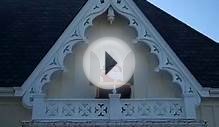
Gothic Revival was one of the most influential styles of the 19th Century. Based upon the ideals and designs of the European Middle Ages, Gothic Revival became popular first in England from the late 1700s, and then spread throughout Europe, America and Australasia in the 1800s. The style was to influence a wide variety of the creative arts. For example Gothic Revival is often linked to a fascination with the chivalry and romance of the Middle Ages, which fed into the creation of the 19th Century Gothic novel. Gothic script, heraldry, and motifs were also often incorporated into new designs for furniture and objet d’art.
In architecture, designers were particularly inspired by the Gothic buildings of the 12th to the 16th Centuries. The fascination with these buildings, especially the churches and cathedrals, was in part linked to philosophical ideals about tradition, conservatism and spirituality. Local architectural commentator C.R.H. Taylor believed that the essence of Gothic included honesty, a love of change, naturalism, rigidity, sturdy strength, the spirit of perseverance, and generosity. “In the structure of Gothic buildings therefore, we find that every detail has a purpose, and each curve and line is a characteristic emblem of its nature…” Architectural elements often found in Gothic Revival buildings, such as those of Canterbury College, might include:
- Pointed and segmental arches
- Steep sloping roofs
- Decorative tracery
- Naturalism in motifs, such as fleur de lis and quatrefoil
- Heraldic motifs, such as chevrons
- Curving figures and emotion in sculpture
- Finials
- Oriel windows
- Cloisters and colonnades
RELATED VIDEO












